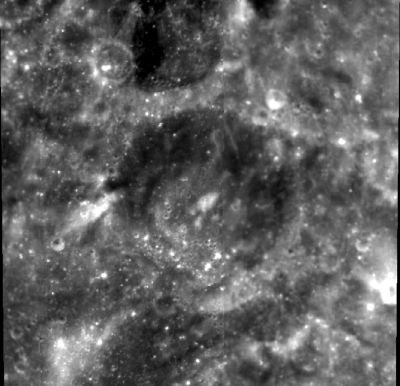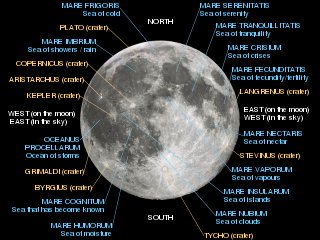
Anaximenes is a low-rimmed lunar impact crater near the north-northwest limb of the Moon. It lies to the west of the crater Philolaus, and northeast of Carpenter. To the northwest is Poncelet, close to the visible edge of the Moon.

Bayer is a lunar impact crater located in the southwest section of the moon, to the east of the crater Schiller. The rim of Bayer is slightly worn by erosion, but remains well-defined. There is an inner terrace, but the outer wall is intruded upon by nearby impacts. The most significant of these is Schiller H, which forms a ridge attached to the northwest rim of Bayer. The floor of Bayer is relatively flat and lacks a central peak. There is a small, but notable crater on the floor near the western wall. This crater has a breach in its northern rim.

Abul Wafa is an impact crater located near the lunar equator on the far side of the Moon, named after the Persian mathematician and astronomer Abu al-Wafa' Buzjani. To the east are the crater pair Ctesibius and Heron. In the northeast lies the larger crater King, and to the southwest is Vesalius.
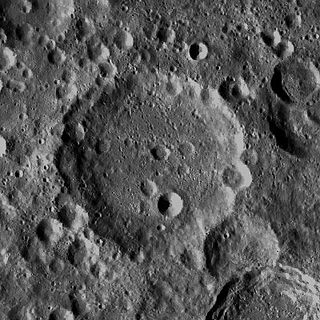
Anderson is a lunar impact crater that is located on the far side of the Moon. It is located to the northwest of the crater Sharonov, and the satellite crater Sharanov X is attached to the southeast rim of Anderson. To the northeast is the peculiar formation Buys-Ballot, and to the east-southeast lies the larger crater Spencer Jones.

Asclepi is a heavily eroded lunar impact crater that lies in the rugged southern highlands of the Moon. The outer rim has been worn down and rounded by many millions of years of subsequent impacts, so that it is now nearly level with the surrounding terrain. As a result, the crater is now little more than a depression in the surface. The interior is nearly flat and relatively featureless.

Atwood is a small lunar impact crater that is located on the Mare Fecunditatis, to the northwest of the prominent crater Langrenus. It forms a triple-crater formation with Naonobu attached to the north rim and Bilharz near the west rim.

Blanchinus is a lunar impact crater that is situated in the rugged south-central highlands of the Moon. The crater is named after Italian astronomer Giovanni Bianchini whose Latinized name is Blanchinus. Adjacent to the south of Blanchinus is the crater Werner, and La Caille is attached to the northwest rim. West of the crater is the prominent formation Purbach.

Dawson is a lunar impact crater that lies on the southern hemisphere on the far side of the Moon. It lies across a crater triplet: the southeast rim is intruding into the crater Alekhin; the northwest rim also intrudes into the larger satellite crater Dawson V, and the northeast rim is attached to the comparably sized Dawson D. To the south of this formation is the large crater Zeeman. West of Dawson is the crater Crommelin, and to the north lies Fizeau.

Chamberlin is a lunar impact crater that is located on the far side of the Moon, just past the southeastern limb. It lies to the southeast of the crater Jeans, and Moulton is attached to the southeastern rim of Chamberlin. This crater is located in a part of the lunar surface that has undergone resurfacing of crater interiors, producing dark-hued crater floors.

Bellinsgauzen is a lunar impact crater that lies in the southern part of Moon, on the far side from the Earth. It is attached to the northern rim of the larger crater Berlage, and within a half crater diameter of Cabannes to the west. North of Bellinsgauzen is the crater Bhabha.
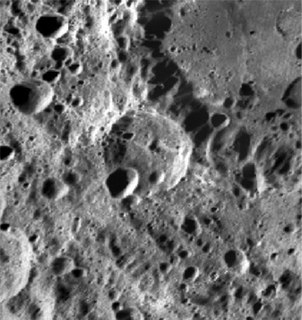
Belyaev is a lunar impact crater that is attached to the outer edge of the Mare Moscoviense, on the far side of the Moon. It is a worn formation with a small crater pair overlaying the southern rim, and several smaller craters across the relatively irregular interior.

Berkner is a lunar impact crater that is located on the far side of the Moon, just past the western limb. It is attached to the east-southeast rim of the crater Parenago. Just to the south is the Robertson, and to the southeast is Helberg.

Boussingault is a large lunar impact crater that lies near the rugged southeast limb of the Moon. Because of its location, Boussingault appears highly oblong in shape due to foreshortening. To the southwest is the crater Boguslawsky, and almost attached to the northeast rim is Helmholtz. East-southeast of Boussingault lies the crater Neumayer.
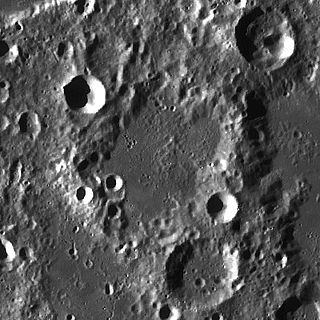
Cajori is a lunar impact crater that is located in the southern hemisphere on the far side of the Moon. It lies to the southwest of the walled plain Von Kármán, and to the east-southeast of the crater Chrétien.

Chandler is a lunar impact crater in the northern hemisphere, on the Moon's far side. It lies to the southeast of the large walled plain D'Alembert, and southeast of the slightly smaller Chernyshev crater.

Weierstrass is a small lunar impact crater that is attached to the northern rim of the walled plain Gilbert, in the eastern part of the Moon. It also lies very near the crater Van Vleck, a similar formation just to the southeast that is almost attached to the outer rim. Due to its location, the crater appears foreshortened as seen from the Earth.

Donner is a lunar impact crater on the far side of the Moon. It is located just to the northeast of the Mare Australe, behind the southeastern limb of the Moon. During favorable librations this part of the lunar surface can be brought into view of the Earth, but the site is viewed from the edge and so not much detail can be seen.

Evershed is a lunar impact crater on the far side of the Moon, named after the English solar astronomer John Evershed. It is located to the northeast of the larger crater Cockcroft, and to the north of the smaller Van den Bergh.

Fridman is the remains of a lunar impact crater on the far side of the Moon. It lies due south of the huge walled plain Hertzsprung, and is attached to the northeastern rim of the crater Ioffe.

Mitra is a lunar impact crater that is attached to the western outer rim of the larger crater Mach, on the far side of the Moon. Just to the west of Mitra is Bredikhin, and to the south-southeast lies Henyey. It is named after Sisir Kumar Mitra.

